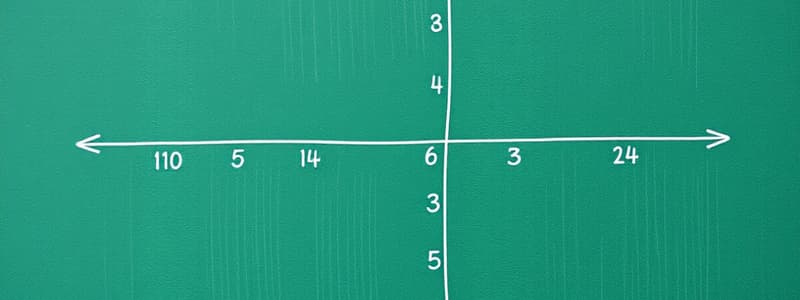Podcast
Questions and Answers
What is the first step in the method of splitting the middle term for factoring a quadratic equation?
What is the first step in the method of splitting the middle term for factoring a quadratic equation?
- Identify the coefficients of the equation (correct)
- Rewrite the equation in a different form
- Multiply the coefficient of x^2 and the constant term
- Find factors of the constant term
In the equation $6x^2 + 11x + 3 = 0$, what are the factors of $ac$ that add up to $b$?
In the equation $6x^2 + 11x + 3 = 0$, what are the factors of $ac$ that add up to $b$?
- 9 and 2 (correct)
- 3 and 6
- 1 and 18
- 6 and 3
After rewriting the middle term in $6x^2 + 11x + 3$, what form do we achieve?
After rewriting the middle term in $6x^2 + 11x + 3$, what form do we achieve?
- $6x^2 + 11x + 5$
- $6x^2 + 2x + 9x + 3$
- $6x^2 + 3 + 9x + 2x$
- $6x^2 + 9x + 3 + 2x$ (correct)
What is the purpose of grouping in the factoring process of a quadratic equation?
What is the purpose of grouping in the factoring process of a quadratic equation?
What does the final factored form of the equation $6x^2 + 11x + 3 = 0$ look like?
What does the final factored form of the equation $6x^2 + 11x + 3 = 0$ look like?
What is a key benefit of splitting the middle term in quadratic equations?
What is a key benefit of splitting the middle term in quadratic equations?
Which statement correctly defines a quadratic equation?
Which statement correctly defines a quadratic equation?
In the quadratic equation $2x^2 - 8x + 6 = 0$, what is the value of $ac$?
In the quadratic equation $2x^2 - 8x + 6 = 0$, what is the value of $ac$?
If a quadratic equation has a discriminant of zero, what can be concluded about its roots?
If a quadratic equation has a discriminant of zero, what can be concluded about its roots?
Which of the following scenarios can be modeled by a quadratic equation?
Which of the following scenarios can be modeled by a quadratic equation?
What do the parameters $p$ and $r$ represent when factoring a quadratic equation?
What do the parameters $p$ and $r$ represent when factoring a quadratic equation?
Which equation represents the process of solving a quadratic equation using the quadratic formula?
Which equation represents the process of solving a quadratic equation using the quadratic formula?
Which expression represents the process of factoring the quadratic equation $x^2 - 10x + 21 = 0$?
Which expression represents the process of factoring the quadratic equation $x^2 - 10x + 21 = 0$?
In the context of quadratic equations, which of the following best describes the term 'vertex'?
In the context of quadratic equations, which of the following best describes the term 'vertex'?
For the quadratic equation $x^2 + 6x + 9 = 0$, what is the nature of its roots?
For the quadratic equation $x^2 + 6x + 9 = 0$, what is the nature of its roots?
Study Notes
Splitting the Middle Term in Quadratic Equations
-
Definition: Splitting the middle term is a method used to factor quadratic equations of the form ( ax^2 + bx + c = 0 ).
-
Steps to Split the Middle Term:
- Identify Coefficients:
- ( a ): Coefficient of ( x^2 )
- ( b ): Coefficient of ( x )
- ( c ): Constant term
- Multiply ( a ) and ( c ):
- Calculate the product ( ac ).
- Find Factors of ( ac ):
- Look for two numbers that multiply to ( ac ) and add up to ( b ).
- Rewrite the Middle Term:
- Replace ( bx ) with the two factors found, resulting in ( ax^2 + m + n + c ) where ( m ) and ( n ) are the factors.
- Group the Terms:
- Group the first two terms and the last two terms: ( (ax^2 + m) + (n + c) ).
- Factor by Grouping:
- Factor out the common terms in each group. This will result in the factored form: ( (px + q)(rx + s) = 0 ).
- Identify Coefficients:
-
Example:
- For the equation ( 6x^2 + 11x + 3 = 0 ):
- ( a = 6, b = 11, c = 3 )
- ( ac = 6 \times 3 = 18 )
- Factors of 18 that add to 11: ( 9 ) and ( 2 ).
- Rewrite: ( 6x^2 + 9x + 2x + 3 )
- Group: ( (6x^2 + 9x) + (2x + 3) )
- Factor: ( 3x(2x + 3) + 1(2x + 3) )
- Final factored form: ( (2x + 3)(3x + 1) = 0 ).
- For the equation ( 6x^2 + 11x + 3 = 0 ):
-
Key Points:
- Useful for quadratic equations that are not easily factored.
- Helps in finding the roots of the equation through the zero-product property.
- Can be used to solve quadratic equations for values of ( x ).
Splitting the Middle Term in Quadratic Equations
- Splitting the middle term is a method for factoring quadratic equations of the form ( ax^2 + bx + c = 0 ).
- Identify Coefficients:
- ( a ): Coefficient of ( x^2 )
- ( b ): Coefficient of ( x )
- ( c ): Constant term
- Multiply ( a ) and ( c ) to find ( ac ), which will assist in determining factors.
- Find Factors of ( ac ):
- Search for two numbers that multiply to ( ac ) and add up to ( b ).
- Rewrite the Middle Term:
- Replace ( bx ) with the identified factors, transforming the equation into ( ax^2 + m + n + c ).
- Group the Terms:
- Rearrange the equation into groups: ( (ax^2 + m) + (n + c) ).
- Factor by Grouping:
- Factor out common terms from each group, leading to the factored form ( (px + q)(rx + s) = 0 ).
Example
- For the quadratic equation ( 6x^2 + 11x + 3 = 0 ):
- Coefficients identified: ( a = 6, b = 11, c = 3 ).
- Calculate ( ac = 6 \times 3 = 18 ).
- Factors of 18 that sum to 11 are ( 9 ) and ( 2 ).
- Rewrite the equation: ( 6x^2 + 9x + 2x + 3 ).
- Group terms: ( (6x^2 + 9x) + (2x + 3) ).
- Factor the groups: ( 3x(2x + 3) + 1(2x + 3) ).
- The final factored form is ( (2x + 3)(3x + 1) = 0 ).
Key Points
- The method is especially valuable for quadratic equations that aren't easily factored.
- Effective in finding roots of equations using the zero-product property.
- Facilitates solving quadratic equations for values of ( x ).
Quadratic Equations
- Quadratic equations are expressed in the standard form: ( ax^2 + bx + c = 0 ).
- Solving involves factoring into the product form: ( (px + q)(rx + s) = 0 ).
- The middle term ( bx ) can be rewritten as the sum of two terms that separately add to ( b ) and have a product equal to ( ac ).
Factoring Polynomials
- Key steps for splitting the middle term include:
- Identify coefficients ( a ), ( b ), and ( c ).
- Compute the product ( ac ).
- Locate two numbers that sum to ( b ) and multiply to ( ac ).
- Rewrite the equation by replacing ( bx ) with the two terms.
- Apply factoring by grouping to extract factors from the rewritten expression.
- Example provided:
- For ( x^2 + 5x + 6 ):
- Coefficients: ( a = 1, b = 5, c = 6 ).
- Product calculation results in ( ac = 6 ).
- The numbers ( 2 ) and ( 3 ) meet the criteria (sum to 5, product to 6).
- The expression is rewritten as ( x^2 + 2x + 3x + 6 ).
- Final factorization yields ( (x + 2)(x + 3) ).
- For ( x^2 + 5x + 6 ):
Roots of Equations
- Roots are solutions for ( x ) in the equation ( ax^2 + bx + c = 0 ).
- Methods for finding roots include:
- Factoring techniques such as splitting the middle term.
- Utilizing the quadratic formula: ( x = \frac{-b \pm \sqrt{b^2 - 4ac}}{2a} ).
- The discriminant ( b^2 - 4ac ) reveals the nature of the roots:
- Positive indicates two distinct real roots.
- Zero results in one real repeated root.
- Negative signals no real roots, leading to complex solutions.
Real-life Applications
- Quadratic equations play significant roles across various disciplines:
- Physics: Used in motion equations and models for projectile trajectories.
- Finance: Applied in calculating profit maximization and cost function analyses.
- Engineering: Important for design optimization and problem-solving scenarios.
- Specific application example:
- The maximum height of a projectile can be modeled with a quadratic equation, where the vertex of the parabola represents peak height.
Studying That Suits You
Use AI to generate personalized quizzes and flashcards to suit your learning preferences.
Description
This quiz focuses on the method of splitting the middle term to factor quadratic equations. Learn the essential steps and practice identifying coefficients, multiplying terms, and grouping for factorization. Ideal for students studying algebra.





